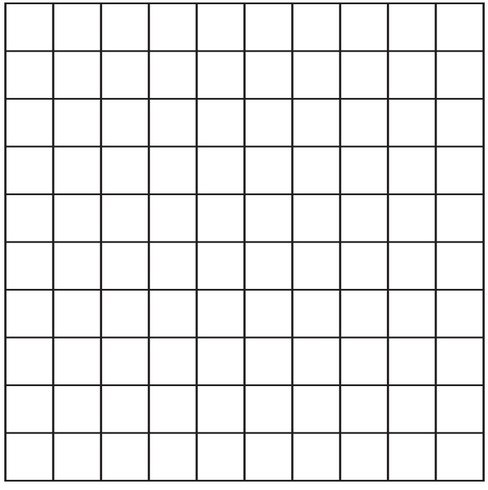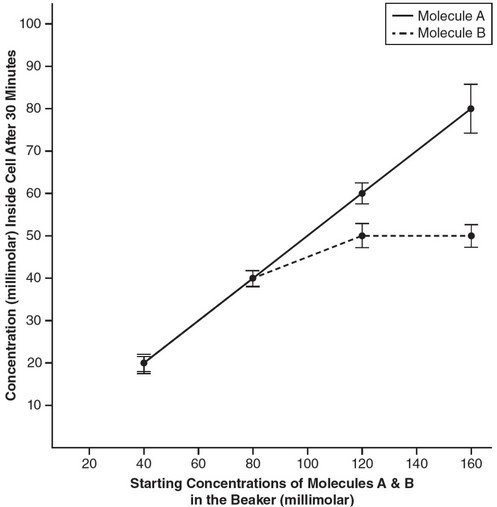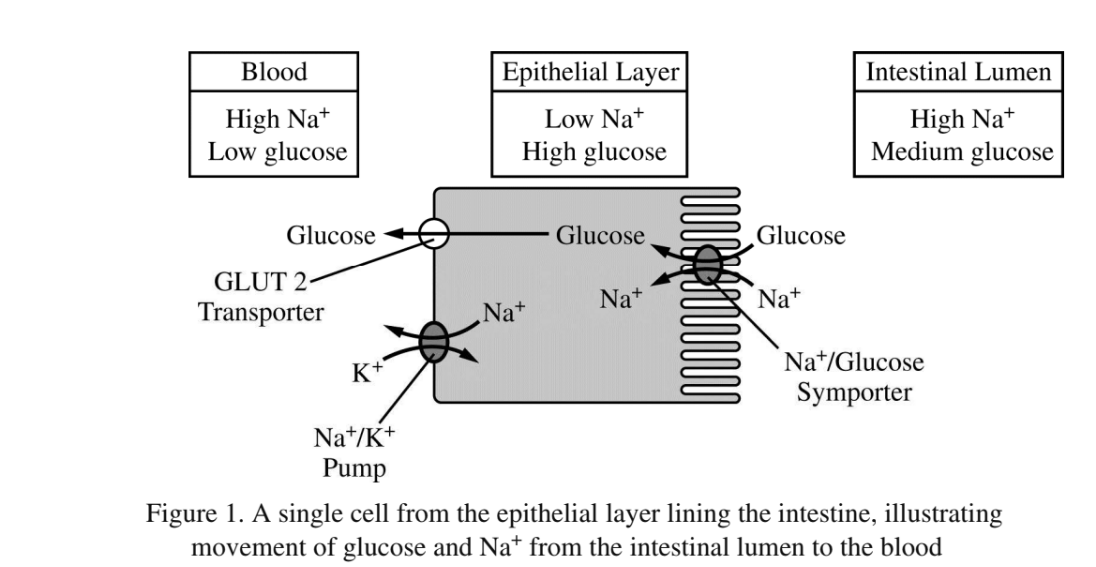Question
Two different molecules, A and B, can enter a cell using passive transport. A cell that did not initially contain molecule A or molecule B was placed in a beaker with a solution containing equal concentrations of both molecules for 30 minutes. The cell was removed from the beaker, and the concentration of each molecule inside the cell was measured.
The experiment was repeated with different, but equal, starting concentrations of molecules A and B in the beaker. The data are shown in the table.
| Starting Concentration of Molecules A and B in the Beaker (millimolar) | Concentration of Molecule A Inside the Cell After 30 Minutes (millimolar) \(\pm\) 2 SEM | Concentration of Molecule B Inside the Cell After 30 Minutes (millimolar) \(\pm\) 2 SEM |
| 40 | 20 \(\pm\) 2.1 | 20 \(\pm\) 2.5 |
| 80 | 40 \(\pm\) 1.9 | 40\(\pm\) 1.8 |
| 120 | 60 \(\pm\) 3.0 | 50 \(\pm\) 2.9 |
| 160 | 80 \(\pm\) 3.2 | 50 \(\pm\) 2.7 |
Standard Error of the Mean
(a) Describe two types of passive transport.
(b) Using the axes provided, construct a graph of this data. Include
95% confidence intervals.
(c) Based on the data, make a claim about which molecule (A or B)
uses simple diffusion and which molecule uses facilitated
diffusion. Justify your claim with evidence from the data.
(d) This experiment is repeated with the addition of a molecule that
irreversibly binds to transport proteins in the cell membrane.
Make a prediction about what, if any, changes this would lead to
in the data. Justify your prediction.
▶️Answer/Explanation
Ans:
(a) Two types of passive transport are diffusion and facilitated
diffusion. In diffusion, a molecule moves from an area of high
concentration to an area of low concentration, and no energy is
required. In facilitated diffusion, a molecule moves from an area of
high concentration to an area of low concentration with the
assistance of a transport protein. Again, no energy is required.
(b) 
(c) Molecule A is using simple diffusion, and molecule B is using
facilitated diffusion. The rate of facilitated diffusion is limited by
the number of transport proteins for the molecule in the cell
membrane. The rate of simple diffusion is not limited by the
number of transport proteins in the cell membrane and will
continue to increase as the concentration difference across the cell
membrane increases. In the experiment, as the concentration of each molecule in the beaker increases, the amount of molecule A
entering the cell continues to increase, but at higher concentrations,
the amount of molecule B entering the cell no longer increases.
This indicates that molecule B is likely using a transport protein to
enter the cell and is therefore using facilitated diffusion.
(d) Since molecule A is simply diffusing across the membrane, the
addition of a molecule that binds to transport proteins will likely
have no effect on the data for molecule A. However, since
molecule B requires a transport protein to enter the cell, the
addition of this new molecule would likely prevent molecule B
from entering the cell.
Question
State two reasons why simple diffusion alone cannot maintain cellular life.
▶️Answer/Explanation
Ans:
(1) Simple diffusion cannot create concentration gradients. The
diffusion of concentration gradients drives many endergonic
processes in cells (including the chemiosomotic ATP production
common to all forms of life).
(2) Specificity of transport requires protein transporters. Without
facilitated diffusion, ions and molecules that do not diffuse through
the bilayer could not be incorporated into cells or be eliminated by
them.
Question

Glucose and sodium move from the lumen of the small intestine into the blood via transport proteins in the epithelial cells lining the small intestine (Figure 1).
- Based on Figure 1, describe the direct source of energy used to move glucose into the epithelial cell from the intestinal lumen.
- Explain how this system maximizes glucose absorption from the intestinal lumen into the epithelial cells and from the epithelial cells into the blood.
▶️Answer/Explanation
Description (1 point)
• Energy from the sodium gradient
Explanation (2 points maximum)
• The \(Na^+/K^+\) pump maintains the sodium concentration gradient and allows for the
cotransport of glucose
• The symport/inflow of glucose maintains a glucose concentration gradient between
the epithelial cells and the blood and allows for (facilitated) diffusion of glucose
• The microvilli/folds on the lumen side of the epithelial cell provide more surface area
for uptake of glucose into the epithelial cell
